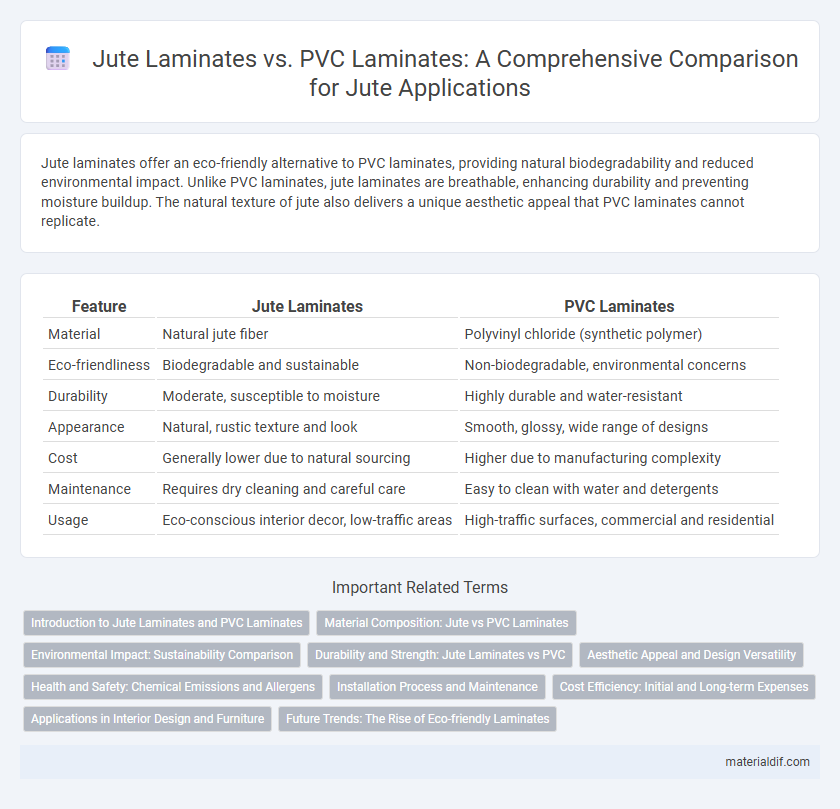Jute laminates offer an eco-friendly alternative to PVC laminates, providing natural biodegradability and reduced environmental impact. Unlike PVC laminates, jute laminates are breathable, enhancing durability and preventing moisture buildup. The natural texture of jute also delivers a unique aesthetic appeal that PVC laminates cannot replicate.
Table of Comparison
| Feature | Jute Laminates | PVC Laminates |
|---|---|---|
| Material | Natural jute fiber | Polyvinyl chloride (synthetic polymer) |
| Eco-friendliness | Biodegradable and sustainable | Non-biodegradable, environmental concerns |
| Durability | Moderate, susceptible to moisture | Highly durable and water-resistant |
| Appearance | Natural, rustic texture and look | Smooth, glossy, wide range of designs |
| Cost | Generally lower due to natural sourcing | Higher due to manufacturing complexity |
| Maintenance | Requires dry cleaning and careful care | Easy to clean with water and detergents |
| Usage | Eco-conscious interior decor, low-traffic areas | High-traffic surfaces, commercial and residential |
Introduction to Jute Laminates and PVC Laminates
Jute laminates are eco-friendly materials made by layering jute fibers with natural resins, offering sustainable alternatives to conventional laminates. PVC laminates consist of polyvinyl chloride sheets that provide durable, water-resistant surfaces commonly used in furniture and interiors. Compared to PVC laminates, jute laminates deliver enhanced biodegradability and reduced environmental impact while maintaining competitive strength and aesthetic appeal.
Material Composition: Jute vs PVC Laminates
Jute laminates are composed of natural jute fibers combined with eco-friendly resin, offering biodegradable and sustainable properties, whereas PVC laminates consist of synthetic polyvinyl chloride layers, providing water resistance and durability but lacking environmental benefits. The organic cellulose fibers in jute laminates contribute to breathability and reduced carbon footprint, contrasting with the petroleum-based composition and potential toxic emissions of PVC laminates. Choosing jute laminates supports greener manufacturing processes and enhances indoor air quality compared to the synthetic, non-biodegradable nature of PVC laminates.
Environmental Impact: Sustainability Comparison
Jute laminates offer a significantly lower environmental impact compared to PVC laminates due to their biodegradability and renewable natural fiber composition, which reduces carbon footprint and waste accumulation. PVC laminates rely on synthetic polymers derived from fossil fuels, contributing to non-biodegradable waste and hazardous chemical release during production and disposal. Sustainable jute laminates promote eco-friendly manufacturing practices and support circular economy principles by enabling recycling and reducing reliance on non-renewable resources.
Durability and Strength: Jute Laminates vs PVC
Jute laminates exhibit natural tensile strength and resistance to wear, making them biodegradable yet surprisingly durable for eco-friendly applications. PVC laminates offer superior hardness, chemical resistance, and longer-lasting performance under heavy mechanical stress, ensuring enhanced structural integrity. When comparing durability and strength, PVC laminates outperform jute laminates in longevity and robustness, while jute excels in sustainable flexibility and moderate protection.
Aesthetic Appeal and Design Versatility
Jute laminates offer a natural, textured aesthetic that enhances interior spaces with eco-friendly charm, contrasting with the sleek, uniform finish of PVC laminates. Their organic patterns and warm tones provide greater design versatility for rustic and eco-conscious themes, while PVC laminates excel in vibrant colors and contemporary styles. The biodegradability and unique grain of jute laminates elevate aesthetic appeal in sustainable design projects where environmental impact is a priority.
Health and Safety: Chemical Emissions and Allergens
Jute laminates exhibit significantly lower chemical emissions compared to PVC laminates, reducing indoor air pollution and minimizing exposure to harmful volatile organic compounds (VOCs). The natural fibers in jute laminates are hypoallergenic, making them a safer choice for individuals sensitive to allergens often released by synthetic PVC materials. Additionally, jute's biodegradability ensures fewer toxic residues during disposal, enhancing long-term environmental and health safety.
Installation Process and Maintenance
Jute laminates offer a straightforward installation process requiring basic adhesives and minimal surface preparation, making them more eco-friendly and time-efficient compared to PVC laminates, which often demand specialized glues and skilled labor. Maintenance of jute laminates involves regular dusting and occasional sealing to preserve natural fibers, while PVC laminates require more frequent cleaning to prevent discoloration and potential chemical damage. The biodegradable nature of jute laminates reduces environmental impact during both installation and maintenance phases compared to the synthetic composition of PVC laminates.
Cost Efficiency: Initial and Long-term Expenses
Jute laminates offer lower initial costs compared to PVC laminates due to the natural and abundant availability of raw jute fibers, making them a budget-friendly option for eco-conscious projects. Over the long term, jute laminates provide superior cost efficiency by enhancing durability and requiring less energy-intensive manufacturing processes, reducing overall maintenance and replacement expenses. PVC laminates, while potentially cheaper upfront, tend to incur higher environmental and disposal costs, impacting the total cost of ownership negatively.
Applications in Interior Design and Furniture
Jute laminates offer eco-friendly, biodegradable alternatives to traditional PVC laminates in interior design and furniture, enhancing sustainability without compromising durability. Their natural texture and aesthetic appeal are ideal for creating warm, organic interiors in residential and commercial spaces. PVC laminates, while more water-resistant and available in a broader range of colors and finishes, often lack the environmental benefits that jute laminates provide.
Future Trends: The Rise of Eco-friendly Laminates
Jute laminates are gaining traction as sustainable alternatives to PVC laminates due to their natural biodegradability and lower carbon footprint. Innovations in jute processing enhance durability and water resistance, making them viable for diverse interior applications. Market demand for eco-friendly laminates is expected to surge, driven by stricter environmental regulations and increasing consumer preference for green building materials.
Jute Laminates vs PVC Laminates Infographic

 materialdif.com
materialdif.com